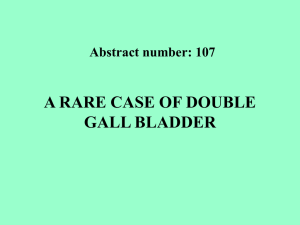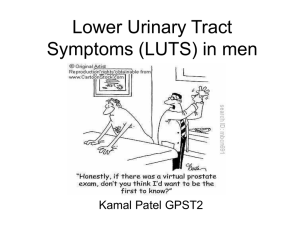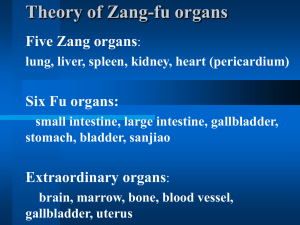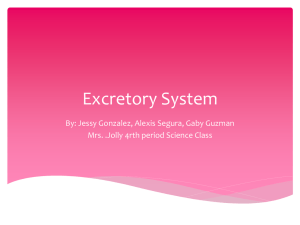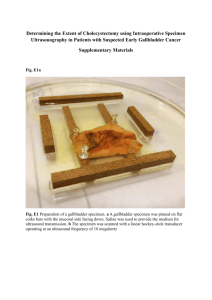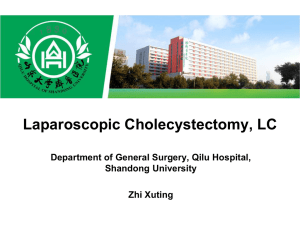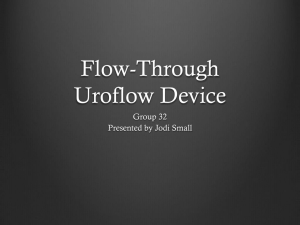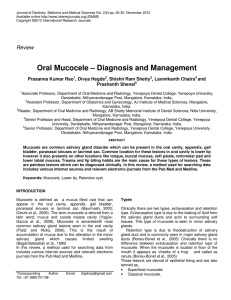Practical-Ultrasound-11-28-2012
advertisement
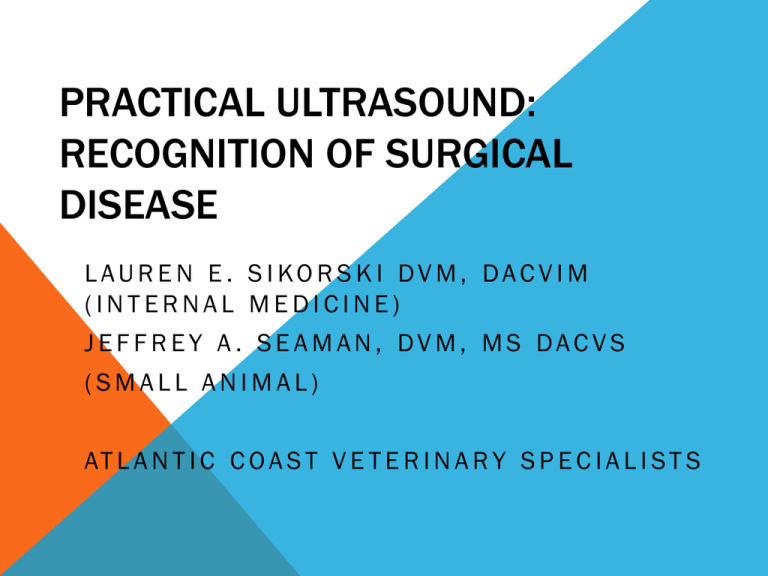
PRACTICAL ULTRASOUND: RECOGNITION OF SURGICAL DISEASE LAUREN E. SIKORSKI DVM, DACVIM (INTERNAL MEDICINE) JEFFREY A. SEAMAN, DVM, MS DACVS (SMALL ANIMAL) AT L A N T I C C O A S T V E T E R I N A R Y S P E C I A L I S T S OUTLINE Pyometra Urinary bladder calculi Splenic masses Intestinal Obstruction Mucoceles FRIDAY 5 PM FEMALE ANATOMY PYOMETRA Thick walled uterus Distended with echogenic material PYOMETRA No wall layering = Not small intestine! Difference of echogenicity indicates settling of cells PYOMETRA KEY POINTS Typical signalment, history and bloodwork findings Uterus appears enlarged between descending colon and urinary bladder Thick uterus distended with echogenic material (cells) PYOMETRA: MANAGEMENT OPTIONS OVARIOHYSTERECTOMY IS TREATMENT OF CHOICE. Pre-operative stabilization: Can use “Rule of 20” SIDEBAR: CHECKLIST MANIFESTO! Atul Gawande, MD •Complications: A Surgeon’s Notes on an Imperfect Science •Better: A Surgeon’s Notes on Performance •The Checklist Manifesto: How to Get Things Right PYOMETRA: MANAGEMENT OPTIONS OVARIOHYSTERECTOMY IS TREATMENT OF CHOICE. Pre-operative stabilization: Can use “Rule of 20” Medical management only considered if: Draining (“open pyo”) NOT systemically ill Breeding potential “Right owner” PYOMETRA OVH – additional considerations: Large incision Delicate tissue handling Pack off with Lap Pads. Avoid clamping uterus; don’t oversew “stump” Larger suture Mortality Rate: 0-8% worse with septic peritonitis Prognosis suggested to be better than other causes of SIRS 48 hours: Increased WBC, Decreased %Neut 7d: WBC often normalized. STRANGURIA URINARY BLADDER CALCULUS 2 small hyperechoic structures associated with the ventral wall of the urinary bladder URINARY BLADDER CALCULUS URINARY BLADDER CALCULUS URINARY BLADDER CALCULUS WHICH PATIENT HAS A URINARY BLADDER CALCULUS? KEY POINTS Usually mobile Dependent portion of the bladder Spherical with a hyperechoic curvilinear interface Presence of distal acoustic shadow is variable Can be confused with sediment CYSTIC CALCULI – MANAGEMENT OPTIONS Medical Interventional/Surgical Catheter-assisted retrieval Voiding hydropropulsion Cystoscopy/Lithotripsy Laparoscopically Assisted Cystotomy CYSTIC CALCULI: CYSTOTOMY Pre-operative evaluation/stabilization Draping Should provide access to external genitalia for intra-op catheterization. Ventral midline celiotomy Skin and SQ curves parapreputial in males Start with caudal celiotomy unless needs further exploration Ventral cystotomy pack off abdomen stay sutures avoid exteriorization CYSTIC CALCULI: CYSTOTOMY Culture mucosa and crushed stone Stone analysis Catheterize, preferably retrograde. Closure various options for pattern – submucosa is critical holding layer! 2 layer continuous Inverting for normal bladder 1 layer interrupted for chronic cystitis suture material monofilament type – consider microbiologic environment poliglecaprone 25 (Monocryl) polydioxanone (PDS) polyglyconate (Maxon) POST-OP RADS ARE MANDATORY! SPLENIC DISEASE NORMAL CANINE SPLEEN NODULAR HYPERPLASIA HEMANGIOSARCOMA 0.6 cm, Illdefined mass of mixed echogenicity replacing most of the normal parenchyma SPLENIC LYMPHOMA Diffuse, small hypoechoic nodules; spotted echotexture SPLENIC LYMPHOMA Solitary, irregular hypoechoic nodule KEY POINTS Variable appearance Hematomas and nodular hyperplasia can mimic hemangiosarcoma Indolent splenic lymphoma has a good prognosis for long term survival Statistics: SPLENIC NEOPLASIA Dogs 33-66% neoplastic May be skewed higher with concurrent hemoabdomen (~80%) ~60-90% of neoplastic are hemangiosarcoma Prognosis (surgery alone) Old studies 19-65d Newer studies 14-470d Cats 37-73% neoplastic lymphosarcoma and mast cell are most common SPLENECTOMY: CONSIDERATIONS Considerations: Incidental Mass vs. Hemoabdomen in crisis OR Equipment: electrocautery, suction, Ligasure, LDStapler, Carmalts Facilities: pRBCs, availability of critical care monitoring etc. Technical Considerations: Always complete splenectomy (never partial) Always perform liver biopsy (guillotine or biopsy punch) Assess pancreas, portal vein Monitor for VPCs during and after Monitor for DIC Other Considerations: Infection Oxygen Transport THE YELLOW DOG THE YELLOW DOG GALLBLADDER MUCOCELE Hypoechoic mucus displaces the echogenic biliary sludge centrally GALLBLADDER MUCOCELE Complete gallbladder mucocele. Gallbladder is distended. Hyperechoic striations radiating toward its center. Central hyperechoic region. Surrounding fat is hyperechoic = rupture. GALLBLADDER MUCOCELE Triagular shape of hypoechoic foci = Stellate pattern AKA Kiwifruit pattern GALLBLADDER MUCOCELE GALLBLADDER MUCOCELE GALLBLADDER MUCOCELE Mucus accumulation leads to overdistension, necrosis and rupture Hypoechoic mucus borders gallbladder wall Mucus centrally displaces echogenic billiary sludge Stellate pattern forms initially Followed by immobile hyperechoic radiating striations GALLBLADDER MUCOCELE In general, a surgical disease Surgical timing is controversial. Higher M&M with EHBDO and/or bile peritonitis Prognosis: Reported perioperative mortality is ~22-32%. In my opinion and personal experience this is lower in relatively healthy patients. Long term survival is very good for those that survive the perioperative period. INTESTINAL OBSTRUCTION CLOTH IN A CAT Bright interface associated with a strong acoustic shadow is suggestive DOG TOY Must be sure to differentiate FB from colon WHICH ONE IS THE FOREIGN BODY? KEY POINTS Dilated, fluid-filled small intestinal loops oral to obstruction Bright interface associated with strong acoustic shadowing Sudden decrease in bowel diameter distal to obstruction Hyperechoic mesentery, free fluid or free gas Do not confuse with feces in colon INTESTINAL OBSTRUCTION Emergency vs. Scheduled Pack off abdomen well, Clean vs. dirty field, Flushing options, Reglove and reinstrument Antimesenteric longitudinal incision: Human “doyens”, Doyens, bobby pins Subjective evaluation: Color, pinch, palpate Trim redundant mucosa, 4-0 pds s/c Linear (cut pyloric anchor first) R & A: Start at mesenteric side, 4 quadrant s/c Leak & Poke test Omentopexy QUESTIONS?


